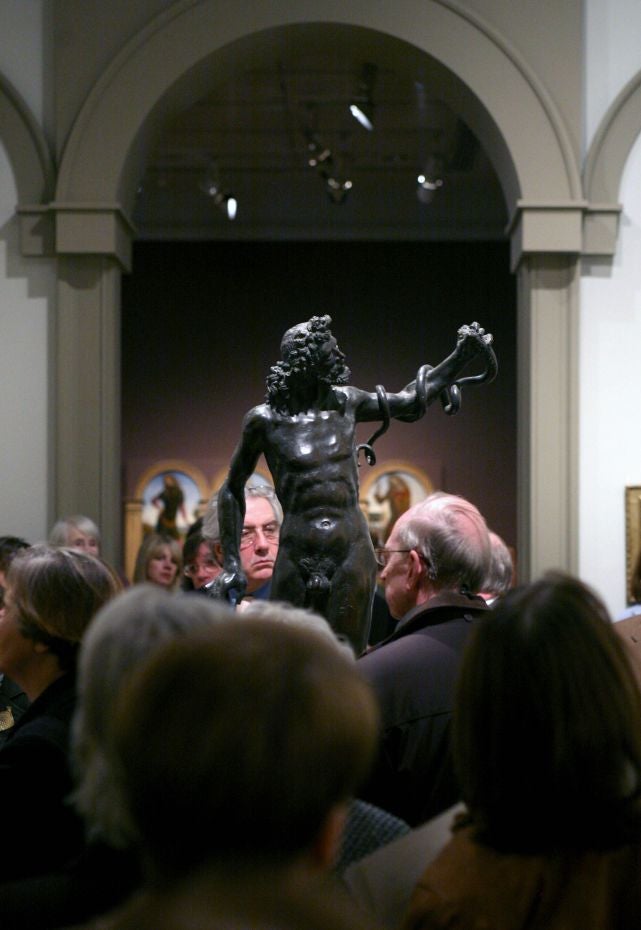The Forgotten Renaissance
The National Gallery’s new show recognises Siena’s unsung role in the cultural rebirth. Ciar Byrne reports

When Giorgio Vasari wrote Lives of the Artists, his guide to the extraordinary flowering of Italian creativity in the 15th century, he concentrated almost exclusively on the art of Renaissance Florence and Venice. Siena, a near neighbour and traditional foe of Florence, barely merited a mention, its considerable achievements overshadowed by the towering legacy of its powerhouse rivals.
But now, with a new show, Renaissance Siena: Art for a City, which opens today, the National Gallery hopes to demonstrate once and for all that art from the final century of the Sienese Republic ranks alongside the finest Florentine and Venetian works.
The exhibition features about 100 paintings and sculptures from Siena, covering a period from about 1460 to 1530. Although Sienese art from the 13th and 14th centuries is universally admired, works from 15th and 16th century Siena have been little known outside of Italy.
By reuniting companion works that have not hung together for hundreds of years, the National Gallery aims to show that Siena’s contribution to Renaissance art was extremely important, albeit very different from that of Florence. One of the most outstandingworks on show is Matteo di Giovanni’s Assumption of the Virgin altarpiece from 1474.
The piece was discovered in 1800 in awoodstore of the Augustinian monastery at Asciano, a town 13 miles outside Siena whichwas part of the city’s territory from the 13thcentury. The splendid central panel showing the Virgin seated on a throne of cherubim and seraphim, rising upwards, which belongs to the National Gallery, has been reunited forthefirst time with the other surviving parts, including side panels depicting St Augustine and St Michael the Archangel.
The Virgin Mary was one of the most popular subjects for Sienese art of this period. Siena called itself the“City of the Virgin” after the Battle of Montaperti in 1260, when the outnumbered Sienese prayed to the Virgin before defeating the Florentine army.
Two other important subjects in the exhibition are Siena’s patron saints, St Catherine and St Bernardino. A life-like statue of the Dominican nun Caterina Benincasa, the youngest of 24 children of a Sienese cloth-dyer, has been loaned from the Oratory of St Catherine in Fontebranda, Siena, for which it was commissioned from the paintersculptor Neroccio di Bartolomeo de’Landi in 1474.
Several works by de’Landi and Francesco di Giorgio Martini depict the Franciscan monk St Bernardino preaching in Siena. Siena’s Piazza del Campo –where the hore race called the Palio takes place – its cathedral and the city walls also feature in many of the paintings in the exhibition, which aims to place the art in the cultural and political context of the period.
The exhibition’s curator, Luke Syson, said: “The paintings of Siena are incredibly beautiful, but very different from the Renaissance that we already know and have been taught about for centuries. We’re looking at a state in the mid-15th to early 16th century which is getting back on its feet after the disastrous effects of the Black Death, but is very conscious of the much more powerful Florence hovering over its shoulder.”
He added that Siena’s interpretation of the Renaissancewas “one that the Florentines more or less wrote out of our history”. He added: “There’s a sheer loveliness which runs through the show; this beauty of line, this exquisite craftsmanship.”
A cast bronze sculpture by Martini, entitled Male Nude With A Snake and modelled on the pose of the famous ancient marble the Apollo Belvedere, stands in the centre of one of the rooms in the exhibition. Looking back at the rear view of the statue from the next room, the viewer’s eye is drawn to another male bottom, in the oil painting Two Nude Youths by Luca Signorelli. Mr Syson described the juxtaposition as “a bottom festival”.
A third male backside – this time clad in red hose – is on display nearby in oneof three pictures telling Boccaccio’s story of the exemplary wife Griselda. It was only when the Griselda paintings, all of which are in the National Gallery’s permanent collection, were cleaned that the gallery was inspired to host the exhibition. The three pictures, whose unidentified painter is known simply as the Master of the Story of Griselda, hang alongside a series of images of heroes and heroines from the ancient world which were made, as the Griselda pictures were, for the rich Spannocchi family of Siena, and have been re-united for the first time in more than two centuries.
The only artist to merit an entire room to himself is Domenico Beccafumi, who Mr Syson described as “the greatest of Siena’s 16th-century artists”. Beccafumi painted the familiar subjects of Sienese tradition – The Virgin and Child with Saints, Saint Bernardino preaching in the Campo and The Stigmatisation of Saint Catherine – in “almost acid colours”.
For the first time in more than 400 years, the exhibition brings together six paintings by Beccafumi which are thought to have hung in the bedchamber of the Sienese merchant and landowner Francesci du Camillo Petrucci.
They include three paintings of women from classical history – Tanaquil, Cornelia and Marcia – all of whom have blonde hair.
“They love blonde women in Siena,” says Mr Syson. “They were famous for their beautiful women. They would send them out to meet visiting dignitaries.”
Renaissance Siena: Art for a City, at the National Gallery, 24 October-13 January, is sponsored by Banca Monte dei Paschi di Siena
Subscribe to Independent Premium to bookmark this article
Want to bookmark your favourite articles and stories to read or reference later? Start your Independent Premium subscription today.

Join our commenting forum
Join thought-provoking conversations, follow other Independent readers and see their replies